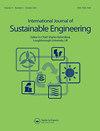可持续加工:车削的环境性能分析
IF 3.6
Q3 GREEN & SUSTAINABLE SCIENCE & TECHNOLOGY
International Journal of Sustainable Engineering
Pub Date : 2021-10-28
DOI:10.1080/19397038.2021.1995524
引用次数: 12
摘要
制造业分别占全球能源和资源消耗的40%和25%。机械加工是制造业中最耗电的操作之一,对环境足迹做出了重大贡献。本研究的目的是确定传统车削对环境影响的关键参数。采用田口L9法设计了一组实验。通过实验分析了aisip20干湿车削过程中的电能消耗、金属加工液(MWF)消耗、表面粗糙度和材料去除率。采用生命周期评价(LCA)方法对转弯的环境性能进行了评价。采用多响应优化方法确定最佳操作条件。结果表明,与干式车削相比,湿式车削具有更好的加工性能和环保性能。LCA结果表明,在大多数影响类别中,电能是最大的贡献者,而MWF的影响可以忽略不计。工件材料和切削刀具材料的使用对水生生态系统和资源枯竭破坏类别的影响有显著影响。在此基础上,提出了综合考虑加工性能和环境影响的优化参数。本文章由计算机程序翻译,如有差异,请以英文原文为准。
Sustainable machining: environmental performance analysis of turning
ABSTRACT The manufacturing sector accounts for 40% and 25% of global energy and resources consumption respectively. Machining is one of the most power-intense operations in the manufacturing sector making a significant contribution to the environmental footprint. The purpose of this study is to identify the key parameters that contribute towards the environmental impacts of conventional turning. A set of experiments was designed using the Taguchi L9 method. Experiments were performed to analyse the electrical energy consumption, metalworking fluid (MWF) consumption, surface roughness, and material removal rate during turning of AISI P20 with both wet and dry machining. A life cycle assessment (LCA) was conducted to assess the environmental performance of turning. A multi-response optimisation was performed to identify the optimum operating conditions. The results show that turning with wet machining yields better machining and environmental performance compared to dry machining. The LCA results reveal that electrical energy is the highest contributor under most of the impact categories, while the effect of MWF is negligible. The use of workpiece material and cutting insert material contribute significantly to the impacts under aquatic ecosystem and resource depletion damage categories. Further, optimum parameters were proposed considering both machining performance and environmental impact.
求助全文
通过发布文献求助,成功后即可免费获取论文全文。
去求助
来源期刊

International Journal of Sustainable Engineering
GREEN & SUSTAINABLE SCIENCE & TECHNOLOGY-
CiteScore
7.70
自引率
0.00%
发文量
19
 求助内容:
求助内容: 应助结果提醒方式:
应助结果提醒方式:


